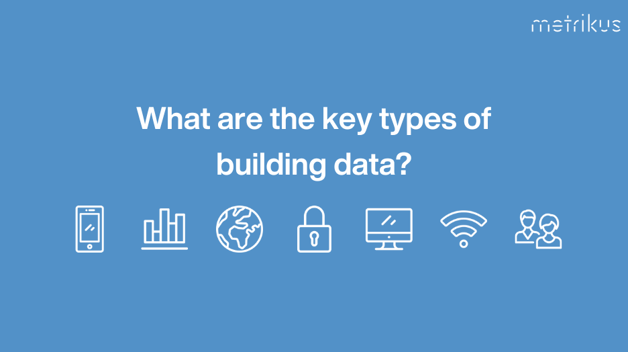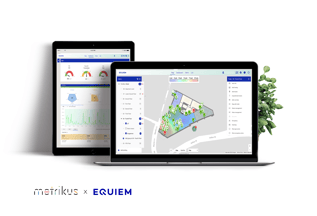What are the key types of building data?
We’re always talking about the value of building data – but how much do you actually know about the different data sources in your space?
We’re not just talking about IoT data, there are a lot of systems in a building that can give you useful information.
It’s safe to say that there are way more than 12, but for the purposes of today’s blog post, we’ve picked some of the top data sets that are worth considering.
1. Occupancy data
Occupancy sensors give you a comprehensive view of how your office space is being used by employees. This data can highlight areas that are underutilized, helping companies to make informed decisions about reallocating space or downsizing.
It’s thought that businesses around the world could save $1.5 trillion in rental costs by avoiding wasted office space, so it’s safe to say that accurate occupancy data can be very valuable.
2. People count data
People count sensors – commonly placed on entry points around your workplace – show you how many people are coming in and out of a particular area.
This data gives you a good understanding of foot traffic, and can help you comply with office capacity limits.
3. Indoor air quality data
Indoor air quality sensors monitor key parameters like temperature, humidity, carbon dioxide, total volatile organic compounds and particulate matter. By setting up custom thresholds and alerts, you can make sure these parameters stay within optimal levels, keeping employees safe and healthy.
Poor indoor air quality – particularly high levels of CO2 – can cause a 23% impairment in decision-making and an 11% reduction in productivity, so making changes to optimize your environment can have a big impact on your bottom line!
.png?width=700&height=390&name=Metrikus%20Platform%20(1).png)
4. Energy data
A massive 30% of the energy used in commercial buildings is currently wasted. But by installing energy sensors, you can start to understand usage trends from individual devices, to floors, to entire buildings.
This provides granular detail, both real-time and historic, around consumption so that action plans can be developed to reduce usage.
5. BMS data
Your building management system (BMS) controls how your office is run.
To create an efficient space, you need to integrate BMS data with other data sources, like occupancy and indoor air quality, so that you can optimize the running of your building in line with actual usage and health.
6. HVAC data
Heating, ventilation and air conditioning (HVAC) systems control your office’s ambient environment.
To find the perfect balance between climate and comfort, HVAC data should be supplemented by real-time indoor air quality data.
7. Room booking data
This does what it says on the tin – provides information about which meeting rooms have been booked and by who.
Things get interesting when you combine this data with occupancy data. Rather than letting no-show meetings clog up meeting rooms, you can automatically free up these valuable spaces when they’re not occupied.
.jpeg?width=700&height=500&name=Easily%20reserve%20a%20meeting%20room%20(2).jpeg)
8. Desk booking data
Desk booking systems allow employees to book their seat ahead of time, and when this data is integrated with occupancy data, desks can be made available if they do not end up being used.
This is a great way of implementing flexible working while maintaining oversight of how much of your office space is actually being used.
9. Badge data
Badge data is an indicator of how many people are working in a space, and is often used to track office attendance.
Although it's a helpful starting point, it’s important to note that the data is not always that accurate and doesn’t show how employees are actually using the office space.
10. Security data
Security technologies – including CCTV analytics, location sensors, and access control – all provide companies with helpful data.
This information can not only be used to keep employees safe in real time, but can be compared with other data sets to determine long-term usage trends.
11. Audiovisual data
Audiovisual (AV) systems from companies like Microsoft, Cisco and Logitech, can provide data on meeting room occupancy and indoor air quality.
This is a great way to start tracking these parameters without the need to install IoT sensors.
12. Employee app data
Employee apps hold a lot of data we’ve already mentioned, including room and desk booking.
With the right systems in place, they can also show employees real-time data so they can make informed decisions about where to work, for example picking a quiet area with low CO2 levels.
.png?width=700&height=500&name=Get%20real-time%20alerts%20to%20improve%20health%20and%20productivity%20(1).png)
Want to start getting value from your building data?
The problem with accessing all this building data is that it tends to be siloed. And this makes it more or less impossible for different stakeholders to access the information they need to make better decisions.
To get real value from your data, you need to be able to bring it together in a single place. Platforms like Metrikus do exactly that – integrating and aggregating data from any source in your building, so you start making data-driven decisions to make your space more efficient, productive and sustainable.
Want to get started? Schedule a call today to discover how to unlock the value of your building data.




